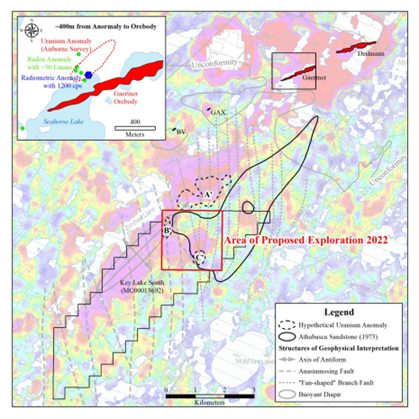Traction Uranium Corp. and UGreenco Energy Corp. announced the start of their Phase 1 Field Geological Program with the mobilization of their field geological group to their Key Lake South Property in Canada’s renowned Athabasca Basin.
 The area of proposed exploration 2022, covering surface uranium anomalies (“B” and “C”), the southwest part of the Athabasca Sandstone mapped in 1973, fan-shaped faults interpreted from airborne geophysics. The background map shows uranium content from the airborne gamma-ray spectrometric survey of 2005. Image Credit: Traction Uranium Corp.
The area of proposed exploration 2022, covering surface uranium anomalies (“B” and “C”), the southwest part of the Athabasca Sandstone mapped in 1973, fan-shaped faults interpreted from airborne geophysics. The background map shows uranium content from the airborne gamma-ray spectrometric survey of 2005. Image Credit: Traction Uranium Corp.
Traction can purchase up to a 75% interest in the Key Lake South Property, which is situated about 6 km southwest of Cameco’s Key Lake Uranium Mill.
Objective: Defining Drill Targets for an Unconformity-Type Uranium Deposit at Key Lake South
To examine surface uranium anomalies from the quantitative gamma-ray spectrometric survey of Ford et al. (2006) and the Athabasca Sandstone delineated in 1973, a region of around 4.15 km2 is targeted for ground exploration (AR 74H04- 0013).
Phase 1: Boulder Prospecting, Mapping, and Sampling
To compare the boulders from surface anomaly “A,” the “Hot Island,” discovered in the early 1970s, boulder prospecting will concentrate on the two surface anomalies (B and C) from the quantitative gamma-ray spectrometric survey of Ford et al. (2006).
Boulder mapping will be used in 2022 to cover the entire projected exploration region to more precisely identify the contours of the 1973 Athabasca Sandstone map (AR 74H04-0013). Boulders of representative sandstone will be sampled for boron analysis.
Underexplored Since the Discovery of Key Lake Deposit
The Key Lake uranium deposit was found due to the early 1970s surface uranium anomaly, which was thought to have been transported from a source in the northeast.
The coincidence between this surface uranium anomaly and the underlying structures, as seen in advanced airborne geophysical surveys from government and industry in the 2000s, lends credence to the idea that this anomaly is in-situ managed by structures instead of erratically transported by glaciers.
Surficial photogeological research with subsequent reconnaissance mappings in 1973 indicated an Athabasca Sandstone relic.
Adjusted locations of the highest uranium content (A', B', and C') immaculately sit around the edge of the Athabasca Sandstone mapped from pebbles during 1973, which might also suggest unconformity-type uranium mineralization preserved beneath the Athabasca Sandstone. The phenomenon at the Gaertner orebody backs up this hypothesis.
Unlocking the potential of our KLS (Key Lake South) Project and getting boots on the ground has been Priority #1 since inking the option agreement with UGreenco. Our team of specialized and experienced geologists and researchers have been looking forward to heading up and getting to work on KLS to complete Phase 1.
Lester Esteban, Chief Executive Officer, Traction Uranium Corp.
Lester Esteban adds, “Immediately after, our team will execute Phase 2—a Ground Gravity Survey to really zero in on high priority targets ahead of our highly anticipated KLS 2023 Drill Program.”